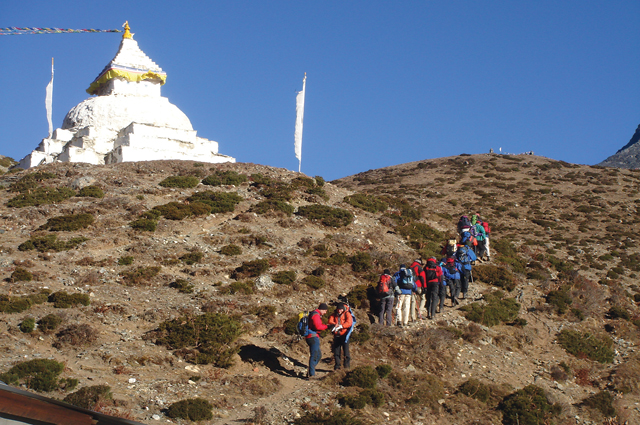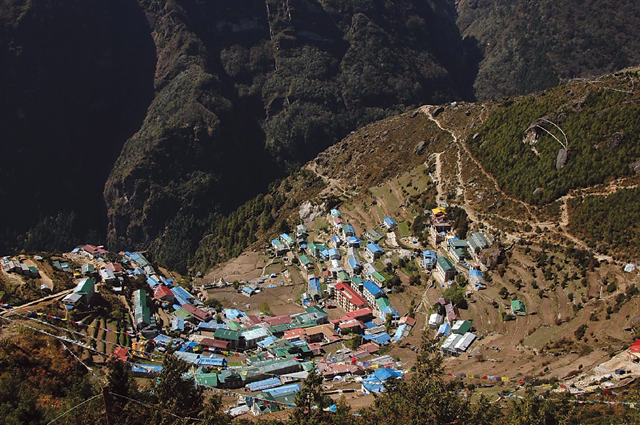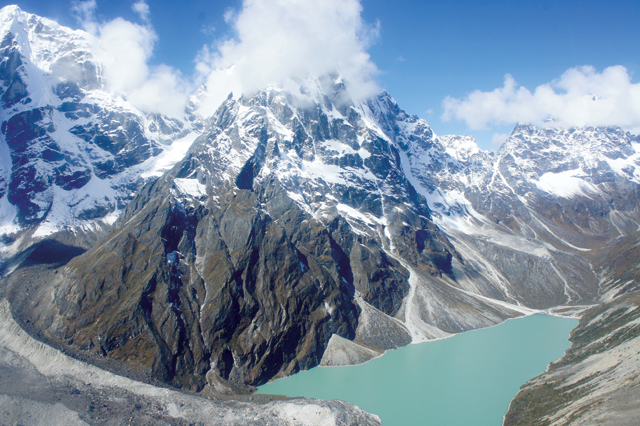Tourism in the Solukhumbu area has been adversely affected due to climate change. The problems, however, run deeper. Apart from the environmental effects, a decline in tourist flow has also led to mounting problems for the locals who are so dependent on the hospitality and trekking industry.

The last four years has seen constant bad weather in Solukhumbu. Naturally, this has led to unpleasant experiences for tourists traversing across the Khumbu region. In 2011, unfavorable weather conditions led to thousands of trekkers being stranded at Lukla Airport, also known as the gateway to the Everest region. This April, we witnessed one of the deadliest disasters on Everest when the avalanche killed 16 people.
Solukhumbu, the home of Sherpa culture, is also where some of the highest mountains in the world can be found. Four peaks that are over 8000m, including Mount Everest, are in this region. The area became famous after the first ascent of Everest by the late Sir Edmund Hillary and Sherpa Tenzing Norgay on May 29, 1953.

Since then, Solukhumbu has become a premier international trekking and mountaineering destination. The opening of the Lukla airstrip in 1964 spurred tourism in the area, with numbers that rapidly increased due to improved air access, promotion and publicity. Tourism continues to grow in the Everest region, and 85% of the population is now involved in the industry in one form or the other (Byers 2013a).

I was born amongst the ancient mountain ecosystems of Solukhumbu 52 years ago. I remember my home village being remote and isolated for most of its history. Poverty was a struggle for all of us. In the past few decades, the impact of human activities on mountain regions has grown significantly due to an increase in population, as well as temporary migration by tourists. Once secluded areas are now open to all kinds of industries, including tourism. Today, as we learn to exploit the mountains for material development and benefits, we are also faced with destruction as a result of an overabundance of visitors. Our inability to develop our mountain ecosystems in a sustainable manner is to be blamed as well.
A tourist entry record at Jorsalle shows that only 20 trekkers visited the Solukhumbu region in 1964. This was followed by 600 in 1971, 5000 in 1980, 10,000 in 1991 and 36,212 in 2012. Today, Sagarmatha National Park is one of the most important mountain tourism destinations in the world (Rogers, 2007).

As can be ascertained by the numbers, tourism is of critical importance for the people of Solukhumbu and is the main source of income for most communities. Although agriculture and livestock still remain important sources of income, the majority of people living there are now more or less engaged in the tourism business. Having grown up in Solukhumbu, I have been privy to both its positive and negative impacts in the area.
On the positive side, tourism has provided ample opportunities in the form of employment via related businesses such as hotels, lodges, trekking and climbing expeditions, etc. Hence, most people living in this region consider their livelihoods to have improved over the past few decades. But, conversely, the influx of tourists has also put pressure on the natural environment.
Deforestation, fuel wood shortages, littering, water pollution, wildlife disturbances, etc are problems that did not exist earlier. The mountain regions are affected by climate change and it is becoming a major environmental issue.
The effects of climate change are being felt around the world, and Solukhumbu is no different. On the increase are natural hazards that have been affecting the tourism business - landslides, avalanches and floods disrupt transport and energy related infrastructures, damage the natural base, affect the health and safety of tourists and put burdens on the development activities and livelihoods of the communities in the region.
The combination of climate change and tourism, it can be said, has been creating a new strain on the Sherpa homeland. Global warming has led to the melting of mountain glaciers. This glacier melt has been adversely affecting biodiversity and weakening the livelihood assets of poor and marginalized communities. The retreat and, in some cases, outright disappearances of glaciers and snowfields in the Everest region have not only increased the risk of catastrophic Glacial Lake Outburst Floods (GLOFs), but have also affected the fresh water supplies of millions of people downstream.
But for the people of Solukhumbu, the problem is not just about losing fresh water; it is also the impact of climate change on the local natural resources they are so dependent on that is a major cause for concern. Their livelihoods, too, are on the line. Tourism is suffering from the various challenges related to global warming, such as the increasingly unpredictable weather patterns that have been disrupting regular flights to Lukla. For over four years now, the constantly changing weather has led to an increased cloud cover in periods of normally clear conditions which, in turn, has led to a decrease in the flow of tourists.
In the past, after the end of monsoon, the weather from late September to December was mainly clear and cold. This was considered the ideal time for trekking in the Khumbu region. A majority of travel agents sold their trip packages during these months because of the favorable weather conditions. But in the peak season of October/November in 2011, approximately 2,500 tourists were stranded for 10 days in Lukla after all commercial flights were grounded due to bad weather. This led to a severe shortage in food and shelter. Tourists were forced to sleep in small tents, the open grounds of the airport and in dining halls of the hotels.
The number of trekkers recorded at the park entrance this year shows that the flow of tourists has dwindled compared to last year. This will significantly affect the livelihood of the locals.
Tourist lodges are a key element in tourism in the mountain areas with hotels along the main trekking routes the largest buyers of locally produced vegetables and other products. The hospitality industry has become an important part of the regional economy and lodges are considered lucrative businesses. Investment in hotels are made from savings from tourism work and low interest loans from friends and families. If the weather continues on, the impacted parties won’t be just the locals but outsiders as well since a majority of lodge owners employ non-local Sherpas, Tamangs and Rais from the south as helpers. It’s therefore apparent that if climate change alters tourism development in a detrimental way, the impact on local livelihoods will be negative as well.
There is a general lack of awareness about the impact of climate change on the tourism industry. Much of what has been discussed has mostly revolved around developed countries. Very little research has been conducted in the mountain destinations of under-developed, or developing, nations. Given the characteristics of the mountains, it appears that mountain tourism destinations are more vulnerable to climate change and even more so in the higher regions of Nepal.
The poor communities in mountainous regions like Solukhumbu are the most impacted group due to their lack of resources in adjusting to challenging conditions. The area has low economic strength, inadequate infrastructure, low levels of social development, lack of institutional capacity, and higher dependency on natural resources. It is therefore crucial to develop adaptation and mitigation strategies specific to mountain environments. Adaptation is necessary to complement such mitigation plans for not only will they produce benefits, but a basis for coping with future climate change will be formed as well.
Realizing the importance of mitigation in the region, The Mountain Institute has conducted a series of community based participatory workshops to raise awareness on climate change and its impact on local livelihood. The institute has already completed the Local Adaptation Plan of Action (LAPA) in three VDCs of Solukhumbu, namely Chaurikharka, Namche and Khumjung.
Reference
- A. Byers (2005) Contemporary Human Impacts of Alpine Ecosystems in the Sagarmatha (Mt. Everest) National Park, Khumbu, Nepal
- Hillary Edmund, 1984. Ecology 2000. Micheal Joseph ltd. London
- Stand Steven 2003: Tourism and deforestation in the Mt Everest region of Nepal, (National Geographical Journal)
- Coburn, B.A. 1984. Sagarmatha: Managing a Himalayan World Heritage Site. “Parks Magazine” Volume 9, number 2.
- Sherpa AR 2010 No More Research but Action in the Imja valley of upper Khumbu region of Sagarmatha National Park and Buffer Zone, internal article
- Sherpa. AR, A. Byers, D. Thapa, T. Bhutia and S.Thing 2004 (Khumbu Alpine Conservation and Restoration Project. A report submitted to The Mountain Institute, Asian Regional Office, Kathmandu, Nepal
- Sherpa. AR and S. Subba (2006) How Tourism Can Help Isolated Communities: National Parks and Protected Areas: International Bulletin
- Sherpa. AR (2012): Community-based participatory research in Imja Valley in Nepal’s Sagarmatha National Park and Buffer Zone, Solu Khumbu, Nepal. Published in Andean-Asian Mountain Global Knowledge Exchange Workshop Proceedings











